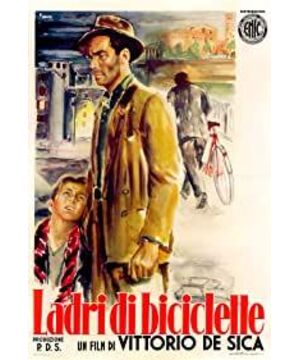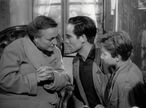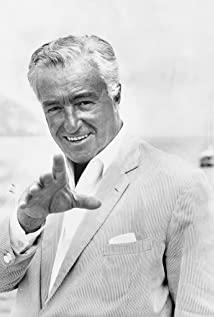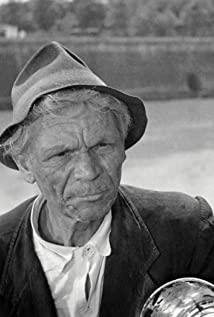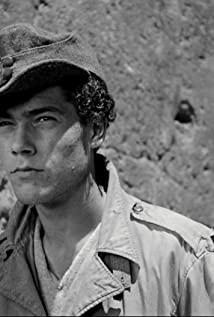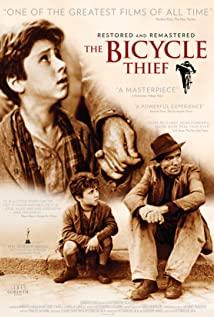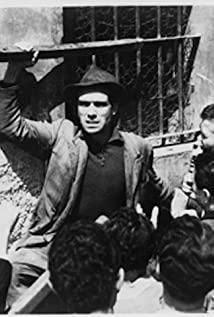Among a group of unemployed workers, only Anton got a job posting a poster, but he was not among the crowd. On the contrary, because of disappointment and exhaustion, he squeezed out the crowd to rest. As people searched for him and he squeezed into the crowd, the camera tracked the disappointed, envied and exhausted faces of the unemployed workers. In genre movies, the main characters are often called out to meet the expectation of big stars; but in this film, the appearance of the non-professional actor Anton is not to meet the expectations of the masses, but to meet the expectations of the masses. For clues, explain more protagonists-a huge group of unemployed workers. Because Anton hesitated for a while on the question of "Are there any bicycles", competitors immediately appeared in the crowd. This kind of scene scheduling method also exists in a lot of movies such as "Schindler's List", but its purpose has been simplified to explain the carefully arranged environment, enrich the amount of information, and strengthen the visual spectacle, rather than pure "documentary." And for the purpose of leaving a copy of Bi Xiao for the real world.
The Anton family bought out their bicycles as sheets. The scene when the pawnshop guys put the sheets on the shelves was extremely shocking. If certain industries developed rapidly after the war, the pawnshops must bear the brunt: the high shelves are several stories high. In order to put the small packages of Andong’s house on the shelves, the guys are not allowed to. Don't climb the huge ladder; in the surprisingly large-scale bicycle rack, the Anton family's hope has finally landed-a small and light bicycle. The scene scheduling of this shot is the same as the opening shot, except that the former shows the state of a person, while the latter reproduces the material life after the war.
On Anton’s first day at work, people and bicycles have become guides to show the environment; this is not enough, the director specially arranged for Anton’s excited wife to jump up and take a peek at Anton’s new work unit. The essential feature of the camera is obtained from the perspective of the main character. strengthen. Anton’s wife went upstairs to thank the fortune-teller, and Anton stood downstairs and waited. This small episode is like a play on a small stage. People come and go, and carefully selected images of idlers and children enrich the overall image of the film. The setting of the group portraits of "idlers" helps to reveal the characteristics of the social era. For example, when we mention the early years of the Republic of China, "idlers" must be caged birds, lifeless and declining aristocrats; when it comes to the 1930s in the United States, "idlers" must be These are hooligan Afei who wear peaked caps and sell alcohol. The image of "idle man" set in this film is not only with some heavy confusion, but also with a certain vitality of the post-war economic recovery period.
In the next scene, Anton rides his young son to work. A bus that stops behind them is crowded with people hanging outside, and the people who get off kicked it easily. The act of opening a little beggar also showed the audience a group of busy and melancholy people who have lost sympathy and patience for their lives. This detail paved the way for the frustration that the father and son had to squeeze the bus home after the bicycle was lost, so that this documentary film can have a complete and contagious plot structure.
If the previous film shows the "face" of social life when the bicycle is lost, then, in the process of looking for a bicycle, Anton and his son led the audience into the bottom of Italian post-war social life. Anton asked friends for help. In a building, the trade union was holding a talk-based meeting; the listless people were rehearsing some listless drama; the driving friends helped Anton find the needle in the bicycle market; the cunning thief and profiteering Vendors control black market transactions; a sudden rain gathered the thief, thieves and owners under a common roof; in the process of chasing the thief, Anton tanned his son for the first time,'Little Bruno couldn't even urinate. Followed his father in the empty square, following the trail of the thief. The crowded post-war simple buildings made people feel suffocated and depressed; while in the historic square, which should have been full of humanities, the figures of Bruno and his father seemed so small and lonely—the environment, whether familiar or unfamiliar, For those struggling to survive, they have lost their beauty and pose a heavy pressure.
Religion should give people confidence, but it was precisely in the church that Anton lost the trace of the thief. Religion is no longer the salvation of the world. In the eyes of disappointed Anton, churches and brothels are both a refuge for thieves and a source of sin.
A man who fell into the water finally made Anton, who was focused on finding a bicycle, remember the existence of his young son, and felt that his brutal attitude had hurt his son's heart; in the following scene, Anton gritted his teeth and asked his son to eat A rich lunch adds a warm atmosphere to the tense and suspenseful plot structure. Of course, the film director has not forgotten to express all kinds of characters in the hotel, in contrast to the group of people in churches and brothels. "Salted fish" in "drama" is called "smoked salted fish", which is a guise and misinformation. Because the taste of smoked salted fish is too strong, it is easy to attract people's attention and cause misunderstandings. Anton thought it was his neglected son who fell into the water. When he saw his son who was almost "lost and recovered" in his mind, the emotional rhythm of the whole film reached a climax, which not only made the plot turbulent, but also At the end, Anton gets comfort from his son and sets a foreshadowing.
In the second half of the film, Anton, who did not believe in fate and prevented his wife from thanking the fortune-teller, finally came to ask the fortune-teller for help. He found the thief’s home and looked for the police. However, this is a poorer and savage area here. He is no longer a victim, but an intruder; a group of poorer people are pressing on him step by step. The classic picture finally appeared. This is the iconic picture of the film. It reveals from a visual and sociological point of view how a person who loses a bicycle turns into a person who steals a bicycle. He is treated by a stronger force. Pushing hard every step of the way, finally came to the point where there was nowhere to go. Anton’s efforts to find a bicycle failed. However, as a clue to lead the audience through real life, his mission has been completed; the rest is to bring the film’s emotions and drama to a climax. He tried to steal the car, but the person who did not steal his car was lucky. He was insulted and beaten by people in front of his son. On the same day, he was both humiliated by the thieves who stole him and by the people who stole him. He was really desperate.
The action of the son picking up his hat is almost the only salvation for him. People were moved by the last bit of dignity embodied by the tears of their sons and the action of picking up hats. The person who lost the bike—the person who looked for a bike—the person who stole the bike, and his son walked silently among the crowds, with bikes after bikes in front of them, like countless thoughts flashing in the hearts and eyes of the father and son. pass. The clasped hands are the last strength that the world can rely on.
Excerpt from "Classic Business Card Reading Tutorial"
View more about Bicycle Thieves reviews


